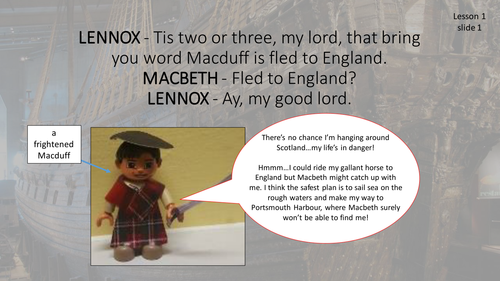




A fun science experiment focusing on the properties of materials linked to Shakespeare's Macbeth. This 6 lesson DT and science learning journey, asks children to design and build a boat using 'junk' and considering the properties of different materials. Includes: presentation, planning, resources and certificate.
Objectives that the learning journey covers, are:
Y3/4
1a. asking relevant questions and using different types of scientific enquiries to answer them
1b. setting up simple practical enquiries, comparative and fair tests
1c. making systematic and careful observations
1d. gathering, recording, classifying and presenting data in a variety of ways to help in answering questions
1e. recording findings using simple scientific language, drawings, labelled diagrams, keys, bar charts, and tables
1f. reporting on findings from enquiries, including oral and written explanations, displays or presentations of results and conclusions
1g. using results to draw simple conclusions, make predictions for new values, suggest improvements and raise further questions
1h. identifying differences, similarities or changes related to simple scientific ideas and processes
Y5/6
2a. planning different types of scientific enquiries to answer questions, including recognising and controlling variables where necessary
2b. recording data and results of increasing complexity using scientific diagrams and labels, classification keys, tables, scatter graphs, bar and line graphs
2c. using test results to make predictions to set up further comparative and fair tests
2d. reporting and presenting findings from enquiries, including conclusions, causal relationships and explanations of and degree of trust in results, in oral and written forms such as displays and other presentations
2e. identifying scientific evidence that has been used to support or refute ideas or arguments.
Objectives that the learning journey covers, are:
Y3/4
1a. asking relevant questions and using different types of scientific enquiries to answer them
1b. setting up simple practical enquiries, comparative and fair tests
1c. making systematic and careful observations
1d. gathering, recording, classifying and presenting data in a variety of ways to help in answering questions
1e. recording findings using simple scientific language, drawings, labelled diagrams, keys, bar charts, and tables
1f. reporting on findings from enquiries, including oral and written explanations, displays or presentations of results and conclusions
1g. using results to draw simple conclusions, make predictions for new values, suggest improvements and raise further questions
1h. identifying differences, similarities or changes related to simple scientific ideas and processes
Y5/6
2a. planning different types of scientific enquiries to answer questions, including recognising and controlling variables where necessary
2b. recording data and results of increasing complexity using scientific diagrams and labels, classification keys, tables, scatter graphs, bar and line graphs
2c. using test results to make predictions to set up further comparative and fair tests
2d. reporting and presenting findings from enquiries, including conclusions, causal relationships and explanations of and degree of trust in results, in oral and written forms such as displays and other presentations
2e. identifying scientific evidence that has been used to support or refute ideas or arguments.
Something went wrong, please try again later.
This is such a cool and original idea! They're going to really enjoy this. Thanks!
Report this resourceto let us know if it violates our terms and conditions.
Our customer service team will review your report and will be in touch.
£3.00
